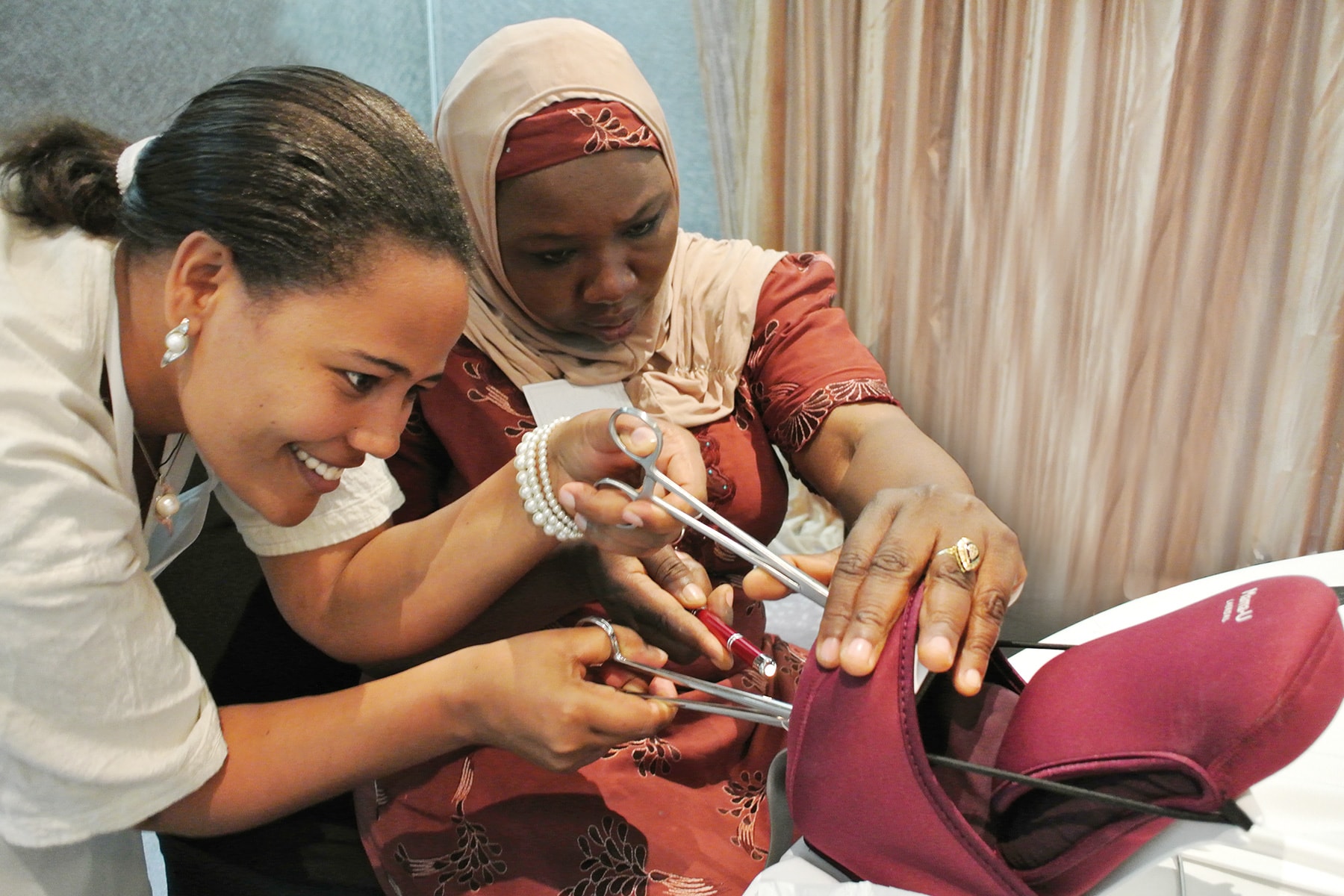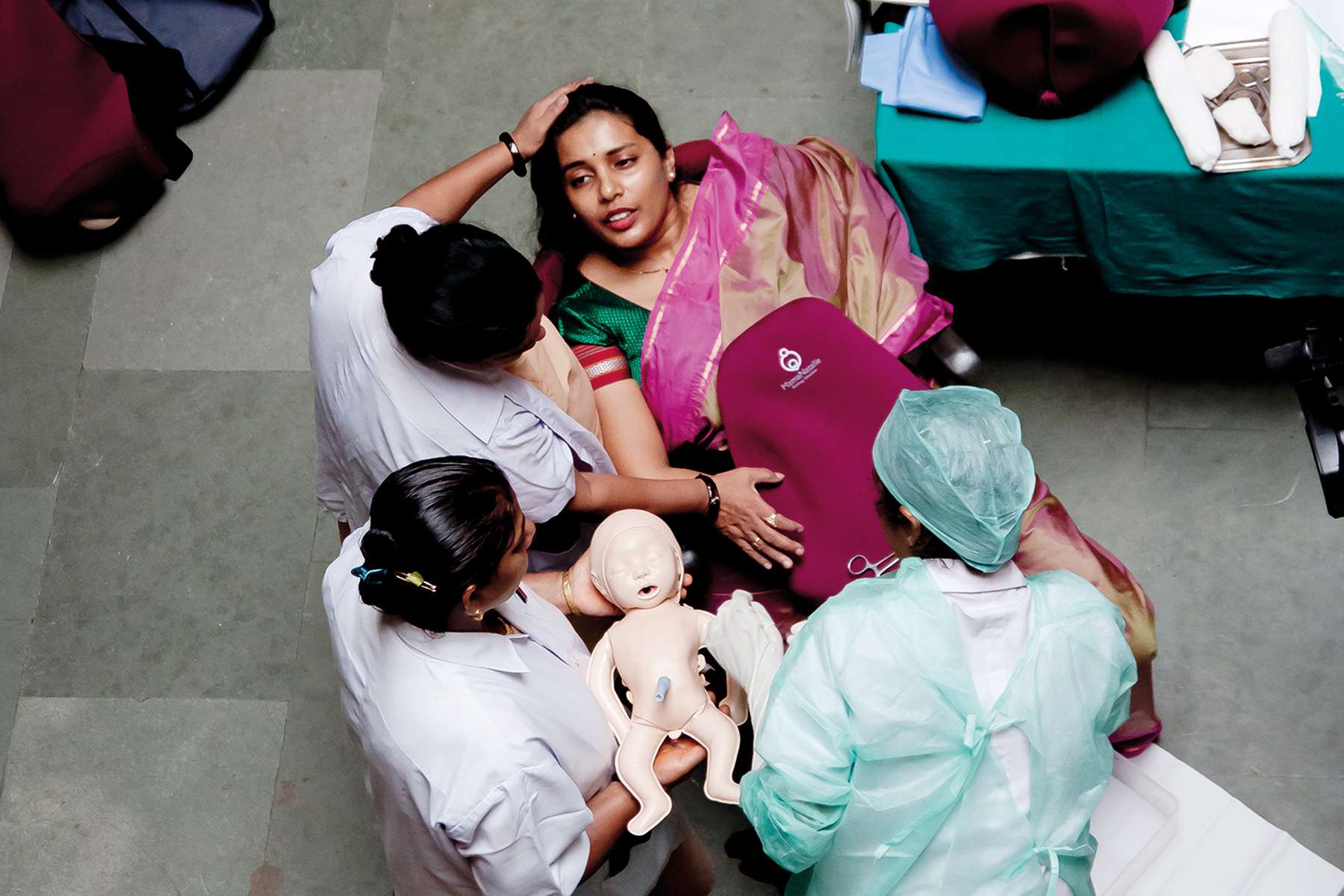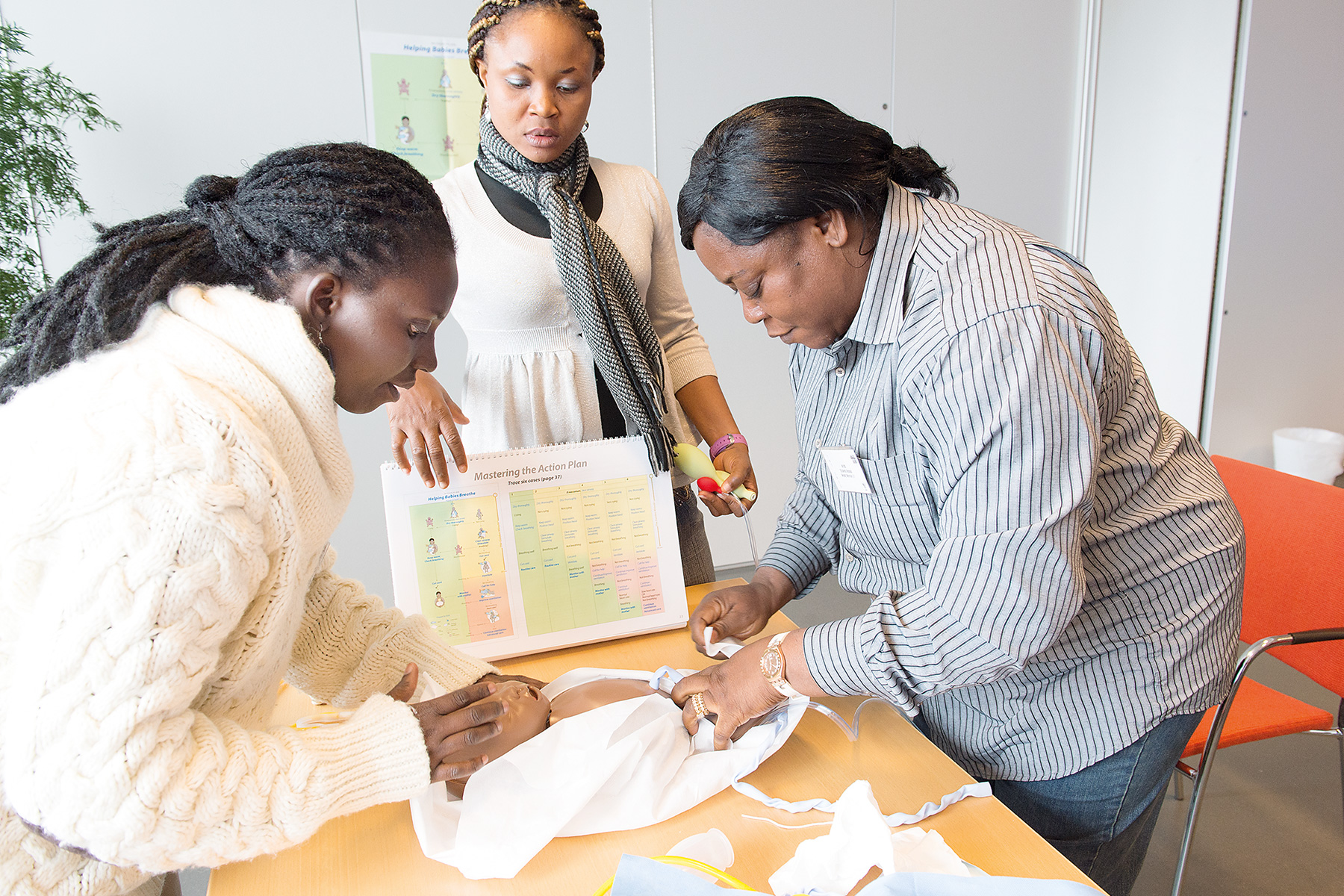
How to Do More with Less in Simulation
Improving Maternal and Newborn Care
What High-Resource Organizations Can Learn From Low-Resource Simulation Success
In 2015, more than 300,000 women died during pregnancy and immediately following childbirth.1 99% of these deaths occurred in developing countries.2 Laerdal Global Health (LGH), a not-for-profit organization funded by Laerdal Medical, develops programs to reduce maternal and infant mortality rates in low-resource countries. We believe a lot can be learned from LGH’s experience that can be transferred to high-resourse environments.
LGH was founded in 2010. Working in partnership with Jhiepego, the American Academy of Pediatrics, and the Church of Latter-Day Saints, LGH has helped make tremendous improvements in the health of new mothers and newborns in developing countries. A study in Tanzania, for example, measured the success of the Helping Babies Breathe Program with a sustained 47% reduction in early neonatal mortality within 24 hours and a 24% reduction in fresh stillbirths after 2 years.3 These same solutions that have made a difference in Tanzania can do the same in the United States and elsewhere.
Though medical facilities and professional training are more advanced in the U.S., there is always room for improvement. Each year in the U.S., approximately 700 women die each year as a result of pregnancy or delivery complications.4 The World Health Organization (WHO) calculates that about half of these are preventable.5 Fortunately, training using simulation is a proven way to identify and reduce preventable error.
In this article, we share how you can transfer Laerdal Global Health’s and its partners experience into your training setting to improve maternal and newborn care.
The Fundamentals of Simulation Will Never Let You Down
In low-resource areas, educators have no choice but to do more with less. The experience of teaching with less in this case, though, has inspired educators to return to the basics of curricular design and the fundamentals of simulation.
Most educators would argue that learning goals are the most important element in any class. As a reminder, without purposeful learning goals, there is no desired outcome to unify you as the educator with your learners.
Many experts recommend that you start with what your desired outcome is. Then, use the SMART framework to craft your learning goals accordingly. Ask yourself if your learning goals are…
| Specific | Measurable | Attainable | Realistic | Time-bound |
LGH’s goal is to help save 400,000 more lives annually by 2020 by providing the tools and training to support health workers.6 By clearly defining what the organisation aims to achieve, LGH can create solutions and programs to help get you there. You, too, can set yourself up for success by using the SMART method to create strong learning goals and, subsequently, strong learning objectives.
As you begin to plan individual simulations, keep in mind the experience level of your learners as well as the setting where your learning will take place. You might not have the funding for a dedicated simulation lab – and that’s okay! Consider the setting of LGH’s trainings in Tanzania and use that as inspiration to get creative with the existing resources, faculty, and equipment you have.
One study compared two simulations – one using a standardised patient at a local hospital and one using a high-fidelity simulator in a simulation lab. In both settings, there were equal improvements among the learners.7 This proves that simulation, rather than the type of simulator, is the key to developing your learners.

Worldwide each year, 140 million women give birth.8 To improve the survival of new mothers and infants, healthcare professionals need to be given engaging and fulfilling training. Simulations that adhere to the best practices in adult learning can provide this. Not every situation requires high-fidelity to gain a high return on learning. Experts recommend matching the level of your simulation with the experience you need to create for effective learning to occur.
Use Low-Fidelity Simulation as a Starting Point
High-fidelity simulation training can lead to tremendous improvements in learner’s skills acquisition. For this reason, many educators adopt a form of tunnel-vision toward only high-fidelity simulation and may lose sight of their desired outcome in the process. Those new to simulation may find funding such high-fidelity simulators challenging and those experienced in simulation may be blind to other, complimentary methods of teaching.
LGH’s experience is proof that low-fidelity task trainers and simulators can vastly improve a learner’s technical skills and interpersonal skills. Without electrical requirements or complicated set-up. Through the Helping Mothers Survive program, developed in collaboration with Jhpiego,we have seen a 17% reduction in postpartum hemorrhage, 47% reduction in retained placenta, 34% reduction in intrapartum stillbirth.9 For this reason, you should not ignore low-fidelity simulation as an option.
There are many simulation methods from which to choose...The key is selecting the technology or method that provides for active engagement with the learner.* |
In the United States, the cost of maternity care exceeds 60 billion dollars, yet women are still dying during pregnancy or childbirth.10 And, an estimated 60,000 women suffer complications that are near-fatal.11 In response, some hospitals are beginning to implement more hands-on training to manage obstetric emergencies – and they are using simulation to accomplish this.
If your simulation program does not have access to a full-body birthing simulator, low-fidelity simulation might be the answer. Birthing simulators and task trainers that can be used with a standardized patient offer an opportunity for learners to engage in real patient interactions. Learners can also practice essential skills for normal and complicated deliveries so that they are prepared to act in an emergency.
One study found that only 43% of learners could successfully address shoulder dystocia emergencies.12 Following a simulated shoulder dystocia scenario, learners improved in the use of basic maneuvers, good patient communication, and higher successful delivery rate.13
Low-fidelity simulation is also a great supplement to your program if you do have a fully-articulating birthing simulator. Learners that are new to the care procedures for a mother in labor may be overwhelmed by the technology of a full-body simulator. In this case, using a low-fidelity birthing simulator or task trainer can ensure that your learners are confident in their skills before introducing them to a more immersive training experience.
LGH’s experience training midwives and other healthcare professionals in rural areas shows the impact low-fidelity solutions can have. Whether your simulation experience level is high or low – or your facility is large or small – low-fidelity simulation is something to consider.
Factor in the Cost-Effectiveness of Low-Fidelity Sims
Creating a realistic training environment is always a challenge. Add to that the complexities of low funding, scarce teaching resources, and limited time for training and it can become quite a puzzle. LGH and its partners have witnessed these challenges first-hand around the world – and helped healthcare professionals overcome them.
For many, simulation training solutions are an investment – not only in improved learning outcomes but also in the inevitable cost-savings and decreased liability to the institution. It’s important to remember that these cost-savings will be in the form of reduced harm and costs associated with harm, rather than from a direct profit.
Our aim is to train healthcare professionals to provide the highest quality care, and there are examples where this can reduce costs…We’re teaching healthcare professionals to pick up on things before they escalate.
Low-fidelity simulation has its place in the learning cycle. It can be a useful training method if your program does not have many funding options. High-fidelity simulation can be costly and will require a larger initial investment, but low-fidelity simulation can provide similar experiences with fewer resources.14 And, low-fidelity simulation can help to mitigate implementation barriers such as low faculty expertise and availability.
In the United States, low-budget clinics and organizations planning community outreach can benefit from the same mentality of cost-consciousness. With so many hospital facilities closing in low-income neighborhoods, clinics are receiving an influx of high-risk patients.15 To better prepare healthcare professionals in urban and rural clinics, the same task trainers and birthing simulators that have been used in low-resource countries should be a consideration in developing any training program.
In addition to the affordability of low-fidelity simulators and task trainers, they are simple and easy to use. Educators with little to no simulation experience can quickly learn how to set up a scenario and are able to make the most of their teaching time. This type of training efficiency allows many students to train in a single learning session and reduces a care team’s time off the floor. For organizations struggling to find time for training, we suggest low-fidelity solutions as a start.
Choosing to invest in low-fidelity products that are within financial reach can still lead to significant reductions in patient harm. The ease of use and productivity are simply an added bonus for educators and trainees alike.
Use LGH's Guidance to Improve the Impact of your Simulations
In the United States, women are more likely to die from childbirth or pregnancy-related causes than other women in the developed world.16 Many hospitals do not conduct simulation, and it’s quite possible that one of the reasons is that they perceive simulation as an expensive endeavor requiring major facilities. Our experience with LGH shows that it does not have to be.
While Laerdal Global Health’s not-for-profit efforts are focused on low-resource countries, their insight and experience can be used to positively influence training within the U.S. Most importantly, their experience in various communities around the world verifies that simulation can be effective in any learning setting – as long as educators have clear objectives and the tools to match.

References
- World Health Organization. (2018). Maternal mortality. Retrieved from: https://www.who.int/news-room/fact-sheets/detail/maternal-mortality
- Ibid
- https://www.aap.org/en-us/Documents/hbs_article_tanzania.pdf
- Centers for Disease Control and Prevention. (2018). Pregnancy-related deaths. Retrieved from: https://www.cdc.gov/reproductivehealth/maternalinfanthealth/pregnancy-relatedmortality.htm
- Agrawal, P. (2015). Maternal mortality and morbidity in the united states of america. Bulletin of the World Health Organization, 93(3). DOI: http://dx.doi.org/10.2471/BLT.14.148627
- Laerdal Global Health. (2018). Helping mothers and babies survive. Retrieved from: https://laerdalglobalhealth.com/
- Crofts, J.F., Winter, C., & Sowter, M.C. (2011). Practical simulation training for maternity care – where we are and where next. An International Journal of Obstetrics and Gynaecology. https://doi.org/10.1111/j.1471-0528.2011.03175.x
- World Health Organization. (2018). Making childbirth a positive experience. Retrieved from: https://www.who.int/reproductivehealth/intrapartum-care/en/
- https://surviveandthrive.org/about/Documents/Survive%20%20Trive%205%20year%20report%20FINAL.pdf
- World Heath Organization. (2018). See reference #8.
- Ibid
- Crofts, J.F., Bartlett, C., Ellis, D., Hunt, L.P., Fox, R., & Draycott, T.J. (2006).
- Ibid
- Ellinas, H., Denseon, K., & Simpson, D. (2015). Low-cost simulation: How-to guide. The Journal of Graduate Medical Education, 7(2). DOI: 10.4300/JGME-D-15-00082.1
- Thomas, L. (n.d.) Poor health: Poverty and scarce resources in U.S. cities. Post Gazette. Retrieved from: http://newsinteractive.post-gazette.com/longform/stories/poorhealth/1/
- Centers for Disease Control and Prevention. (2018). See reference #4.
* Aebersold, M. (2018). Simulation-based learning: No longer a novelty in undergraduate education. The Online Journal of Issues in Nursing, 23(2). Retrieved from: http://ojin.nursingworld.org/MainMenuCategories/ANAMarketplace/ANAPeriodicals/OJIN/TableofContents/Vol-23-2018/No2-May-2018/Articles-Previous-Topics/Simulation-Based-Learning-Undergraduate-Education.html
** New Jersey Health Care Quality Institute. (2018). Take five with james Spaulding, bsn, rn, ccrn, sim lab coordinator at st. peter’s university hospital. Retrieved from: http://www.njhcqi.org/take-five-with-james-spaulding-bsn-rn-ccrn-sim-lab-coordinator-at-st-peters-university-hospital/
